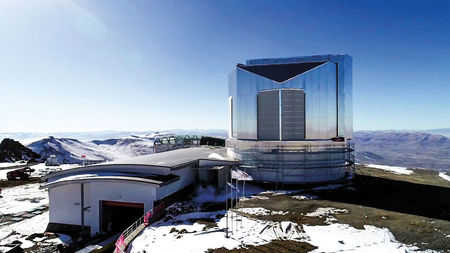‘We put everything into it.’ Modest telescope could have big impact on Turkish science – Science Magazine

A new telescope, under construction on a 3170-meter mountaintop in eastern Turkey, is expected to come online next year.
ATATÜRK UNIVERSITY ASTROPHYSICS RESEARCH AND APPLICATION CENTER/ANADOLU IMAGES
International megaprojects that cost well over $1 billion generate most of the excitement in observational astronomy today: the 39-meter Extremely Large Telescope under construction in Chile, for example, or the Thirty Meter Telescope, controversial because of its proposed location on Mauna Kea, a mountain sacred to some Native Hawaiians.
But smaller telescopes still do cutting-edge science as well. And Turkish scientists are eagerly awaiting the completion of the new Eastern Anatolia Observatory (DAG), a 4-meter optical and infrared telescope expected to come online next year. Its main structure is scheduled to be shipped to the site, a 3170-meter mountaintop in northeastern Turkey, this month; polishing and grinding of the primary mirror is nearly done.
Despite its modest $34 million price tag, DAG will be one of Asia’s largest optical telescopes and Turkey’s largest science project. Its developers hope DAG will make Turkey a regional astronomy hub and help nurture its astronomy community. “We are dreaming of using the instruments on DAG,” says Ozgur Basturk, an exoplanet scientist at Ankara University. “With a 4-meter telescope, we can do much better and be more competitive in our field.”
Turkey’s largest telescope today is a 1.5-meter reflector near the city of Antalya on the Mediterranean coast. The new facility will sit well above haze and humidity and far from urban light pollution, and enjoy 288 clear nights per year on average. Its design and construction, financed by the Turkish government, has involved scientists at 40 universities in the region, along with European academic and industrial partners. “It’s not a 40-meter telescope of course,” says Laurent Jolissaint of the University of Applied Sciences and Arts of Western Switzerland, the project’s lead optical engineer, “but we put everything into it. The optics system is the same essentially as the very newest systems.” DAG will be run by the Astrophysics Research and Application Center at Atatürk University in Erzurum, a city in eastern Turkey.
Turkish scientists have little access to the world’s largest telescopes. The European Southern Observatory (ESO) in Chile, for instance, prioritizes observing time for projects led by scientists from the 16 nations that have helped pay for the facility and contribute to its €162 million annual budget. “In principle, anyone can apply to use these telescopes, but the competition is very high, so the research quality [of your proposals] should be high,” says astronomer Sinan Alis of Istanbul University. “You have to somehow reach that level to be able to compete.” In 2010, Turkish astronomers began to lobby their government to apply for ESO membership, but they gave up a few years ago, their hopes dashed by Turkey’s economic crisis. (Another developing country, Brazil, dropped its membership bid last year because it could not afford €270 million in fees over the next decade.)
Unable to make observations themselves, many Turkish astronomers fall back on archival data from large telescopes that have already been picked over by other astronomers, who can take years to release them. Some Turkish astronomers have struck up collaborations with teams from ESO member countries, but even then, getting travel funded is often difficult.
That’s why the new telescope will be such a boon, Basturk says—for instance, for his exoplanet research. DAG will allow him to use one of the standard strategies for hunting exoplanets: monitoring stars for a wobbling motion that results from the gravitational tug of an orbiting planet. But like other premier telescopes, DAG will also have a coronagraph, an instrument that masks bright stars to remove their glare so that dim planets orbiting them can be imaged directly. New technology will enable the coronagraph to block multiple stars at the same time, needed to hunt for exoplanets in star systems that, unlike our own, have two stars or more.
DAG’s large aperture will enable it to capture light from distant, faint objects like high redshift galaxies, allowing astronomers to probe far back into the universe’s history. That’s important for Alis, who hopes to use DAG to follow up on data from the Spektr-RG space observatory, a Russian-German satellite launched last year to map the x-ray sky. Many objects can produce x-rays, from black holes at the centers of galaxies to smaller black holes or neutron stars consuming mass from a companion star. “We need to follow up with optical and infrared to see what they actually are,” Alis said.
In an ironic twist, DAG officials say astronomers from several European countries have shown interest in Turkey’s new observatory, despite their access to ESO’s megatelescopes, drawn by the location—there are few others in the Northern Hemisphere at that longitude—and affordable observation time. “We envision DAG as an international observatory,” says the project’s director, Cahit Yeşilyaprak of Atatürk University. “We do not have a preference about the origin of the proposals, as long as the best science cases are proposed and conducted.”
But the biggest impact will be in Turkey itself. Designing the telescope has already pushed science in other fields. For instance, dozens of optical, mechanical, and computer engineers helped design the telescope’s adaptive optics system, which will sharpen its images, and its derotator, a device that keeps the telescope trained on the same spot as the Earth rotates. “These are big deals for a developing country,” Yeşilyaprak says. And the telescope itself will invigorate Turkish astronomy, Alis says. “Once we have the telescope, the expertise will pop up.”





